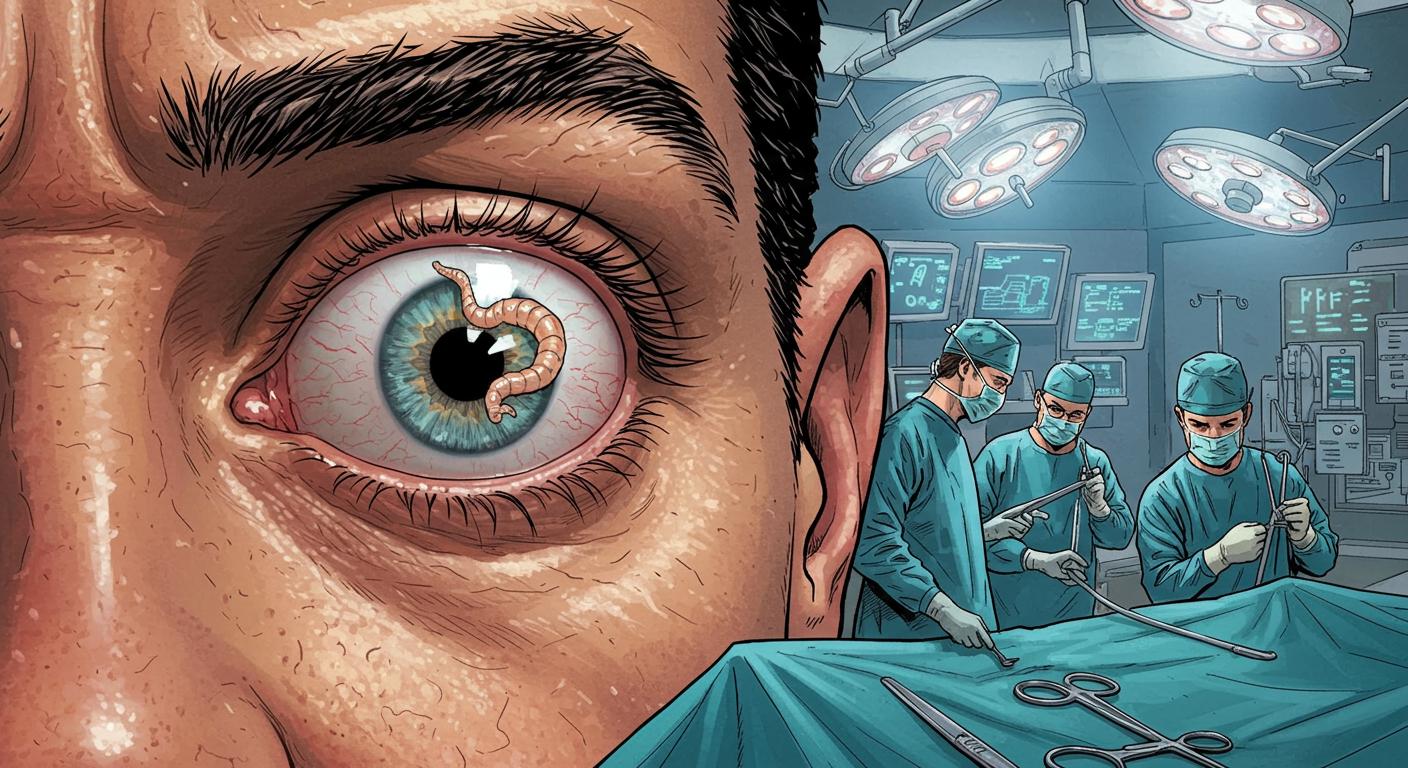There are days when I stumble across a story so vivid, so specifically crafted to ping every hardwired “no, thank you” response in the human brain (mine included), that I almost suspect a cosmic prank. Today, that dubious honor goes to the saga of a gentleman in India, an unfortunate nematode, and, well, some missing eye jelly.
Eye Spy With My Little…Nematode?
As detailed in Ars Technica’s report, a 35-year-old man endured an eight-month struggle with persistent redness and blurred vision in his left eye. It wasn’t an errant eyelash, rogue pollen, or a dust mote causing the trouble; when doctors at an ophthalmology clinic investigated, they discovered something altogether more mobile. Specifically, they observed “a small worm, which they watched ‘moving sluggishly’ in the back of his eyeball”—yes, that’s a direct quote provided in the case report, referenced by Beth Mole.
To evict the unwelcome guest, the medical team employed what’s known as a pars plana vitrectomy. According to the case as described in the New England Journal of Medicine and relayed by the Ars Technica article, this procedure usually addresses various retinal and vitreous issues, not unscheduled parasite extradition. The process involves making minuscule incisions in the sclera (the white of the eye) and inserting a needle-like suction device to extract some of the “eye jelly” (officially: vitreous). In a twist that feels designed specifically to haunt ophthalmology students, the device managed to suck in part of the worm’s tail and drag out the whole creature—still very much alive and wriggling—according to the report cited in the article. Under the microscope, the nematode was identified as a larval-stage Gnathostoma spinigerum, primarily notable for its cephalic bulb, thick cuticle, and a well-developed intestine. The details in the outlet’s summary are oddly thorough—helpfully ruining lunch for at least several readers, myself included.
Worm Like Me: The Inadvisably Versatile Gnathostoma
As outlined by Ars Technica, G. spinigerum is not your average, content-to-mind-its-own-business parasite. It’s native to India, where it infects carnivorous mammals—especially cats and dogs—forming tumor-like masses in their intestines. The outlet points out that these adults mate, and their eggs exit the body via feces, inevitably contaminating freshwater where plankton, fish, and amphibians can join the party. Paratenic hosts like birds (including chickens) and snakes may also host the young worms, at which point evolutionary ambition reaches what I can only call “choose your own misadventure” levels.
Humans are, categorically, not the intended target (being what parasitologists refer to as “dead-end hosts”), and yet we unwittingly enter the cycle by consuming undercooked meat from infected intermediaries. As recounted in the report, after ingestion, the larvae burrow through the digestive tract—initially causing vague symptoms like fever, fatigue, or abdominal pain—before embarking on a more whimsical DIY tour of the body. Most often, they end up in the skin, leaving red, itchy rashes that last for weeks. However, as the current case illustrates (with the patient’s symptoms highlighting the full bizarre potential), the larvae can detour into the lungs, bladder, ears, nervous system, brain—and, every so often, the eye.
Interestingly, the man described in the report avoided the more sprawling consequences; CT scans of his brain, skull, chest, abdomen, and pelvis were clear. The only sign of trouble was the ocular trespasser itself. Following a successful nematode removal, the doctors prescribed both oral and eye-drop corticosteroids for inflammation and administered anti-parasitic medication. As highlighted by Ars Technica, while his overall symptoms showed improvement after eight weeks, a secondary complication—cataract formation, fairly standard after vitrectomy—limited his visual recovery.
Things You Can’t Unsee
There’s a particular breed of story whose power to unsettle comes less from hyperbolic reporting and more from the cold recitation of facts—the sort found in case studies and carefully-worded medical journals. This tale, as chronicled by Beth Mole for Ars Technica, is one of those. The spectacle of a parasite simply fulfilling its life cycle would almost deserve respect, if it didn’t so blithely ignore human standards for bodily autonomy and ocular peace.
Perhaps the detail that best encapsulates my reaction is the image—distinct in its specificity—of a wriggling nematode being siphoned from an eye, followed by the brisk scientific note that this is a “rare” but not “unheard of” scenario for certain Indian hospitals. Stories like this rekindle the fading awareness that, despite our best efforts at hygiene and culinary caution, the universe has a fondness for dispatching evolutionary curveballs.
Is this a plug for more robust food safety campaigns? An advertisement for the unsung heroism of ophthalmic surgeons? Or, maybe, just one more entry in the long list of stories you wish you could unread, but will inevitably find yourself describing (in alarming detail) at dinner?
Either way, the key lesson seems to be: if something is moving inside your eye, don’t wait eight months before letting someone else take a look. And if you’re off to research “pars plana vitrectomy”—perhaps wait until after dessert.
Some days, the line between science and nightmare fuel is thinner than you’d like.







